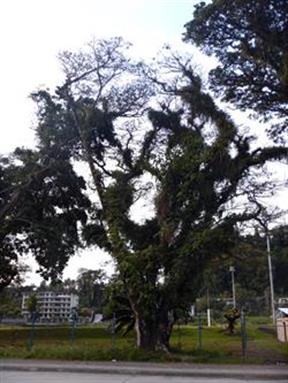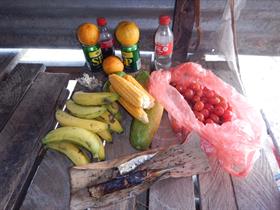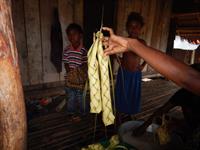page created 19th December 2014
Thursday, 25th September
I am waiting for a PMV on the side of the road. I see a line of people - the village chief, the priest and even the teacher who had set a homework to her students to come and say goodbye. Nice!
I am waiting for a PMV on the side of the road. I see a line of people - the village chief, the priest and even the teacher who had set a homework to her students to come and say goodbye. Nice!
Note the bandages! I suppose the baby wanted the same as her dad.
We follow a vast plain between two mountain ranges. Industrial plantations are invading all the good land.
Palm oil plantation.
Sugar cane plantation.
How to make a basket from a palm leaf.
We arrive at Lae where there is a religious meeting. Papuans are very gullible, so they are overwhelmed by all the missionaries and all the sects of the world. I even saw the Baha'i.
Here are some photos taken en route to Lae.
By the way, a PMV is a coach (Public Motor Vehicle - see info)
After arriving in Lae (pronounced 'Lee') I go to the port, but all the dinghies to the surrounding villages have already left.
The man in charge of the petrol pump at the Yacht Club invites me to sleep at his place. It is in the largest (infamous) slum (settlement) of Lae. Later on, he returned drunk and snored in the hut. Four-year-old children were watching television until one in the morning. I decided to sleep outside. It is impossible sleep, eaten by mosquitoes with lots of drunk people around who won't stop shouting.
It was only later that I understood why they got drunk on a Thursday. The sale and public consumption of alcohol is prohibited on Friday, Saturday and Sunday. So they get drunk some other day! ...
The man in charge of the petrol pump at the Yacht Club invites me to sleep at his place. It is in the largest (infamous) slum (settlement) of Lae. Later on, he returned drunk and snored in the hut. Four-year-old children were watching television until one in the morning. I decided to sleep outside. It is impossible sleep, eaten by mosquitoes with lots of drunk people around who won't stop shouting.
It was only later that I understood why they got drunk on a Thursday. The sale and public consumption of alcohol is prohibited on Friday, Saturday and Sunday. So they get drunk some other day! ...
Sometimes there are more epiphytes than the leaves of a tree. This is quite common in equatorial areas.
I ask to be taken to a very quiet and secluded village.After a long wait in the drizzle, I find someone to take me. An hour in the pouring rain with no way to protect themselves.
Approaching a beach and the driver asks me "Do you want to land here? "Yes," You really want to land here !? "Yes," Are you sure you want to land here? !! "Uh ... Yes.
I jump on the beach and the dinghy leaves.
Approaching a beach and the driver asks me "Do you want to land here? "Yes," You really want to land here !? "Yes," Are you sure you want to land here? !! "Uh ... Yes.
I jump on the beach and the dinghy leaves.
Immediately the whole village rushes to me and they all start to question me like a police interrogation. Why have you come here? What are you looking for? Do you have the authorization? Where do you come from? Which company sent you? Etc. I was too tired to stand it for long - how could I make them understand that I was exhausted by a month of travel and I was looking for a quiet and friendly area to rest a few days?
I learned later that they had only seen one white person before, a German, and that was over ten years ago.
Fortunately the village head (not friendly) and one of his friends Mathew, friendly, and, as I would find out later, very cultivated, arrived. They extracted me from the crowd and took me a little further away where we sat and talked quietly and calmly.
Later the village leader and Mathew asked where I wanted to sleep. I point out an empty hut on the edge of the beach. It is quickly agreed that this will be my home for three days.
I learned later that they had only seen one white person before, a German, and that was over ten years ago.
Fortunately the village head (not friendly) and one of his friends Mathew, friendly, and, as I would find out later, very cultivated, arrived. They extracted me from the crowd and took me a little further away where we sat and talked quietly and calmly.
Later the village leader and Mathew asked where I wanted to sleep. I point out an empty hut on the edge of the beach. It is quickly agreed that this will be my home for three days.
Here is the hut by the beach, with my battery charging solar panel on the roof, and my blanket and mosquito-proof hammock inside.
I spend the next two days sleeping at night, sleeping in the morning and sleeping the afternoon. Between naps, I go to the market, I swim amongst the corals and I take some pictures. In the evenings, Mathew and I change the world!
Friday, 26th September.
I return to Voco point, from where the dinghies depart.
I return to Voco point, from where the dinghies depart.
My food:
A panorama taken from the sea. My hut is the one with the red roof.
I had chosen a camera that can go down to 18m under the sea. Unfortunately this is the only photo I had time to take in two months of travel.
The biloum bags are used for everything.
No road, no trail, no vehicles, no electricity, no telephone and no internet. The canoe is the only means of transport. Travelling along the coast they pass by my house.
.
Sunday, 28th September.
Today marks half the journey!
Today is Sunday. Neighbours prepare the meal. Rice with coconut.
Today marks half the journey!
Today is Sunday. Neighbours prepare the meal. Rice with coconut.
Coconut is grated using a special chair which is found in every house. The grated cocunut is washed and the rice cooked in the resulting liquid. Small palm-leaf baskets are filled with the boiled rice. There are different sized baskets. The rest of the meal is prepared with beautiful vegetables. Everything will be shared with neighbors and friends.
Click on any photograph to zoom in!
Monday, 29th September .
I'm now in great shape, well rested. Bad luck - it is overcast and raining most of the time. I go for a walk and take some pictures.
I'm now in great shape, well rested. Bad luck - it is overcast and raining most of the time. I go for a walk and take some pictures.
The first day I had picked up a piece of coral in the sea. Since then, all children in the area competed to cover my steps with coral. They must have been disappointed when they saw that I had left them behind. Coral is very fragile and I only have a small back-pack.
Tomorrow I go back to Lae.
Apart from that first meeting, I must say that the villagers were wonderful.
Apart from that first meeting, I must say that the villagers were wonderful.
A talking drum - like those in Africa
Tuesday, 30th September
Departure from Busamang
Departure from Busamang
I go to the old airport to buy my ticket to Port Moresby and find there a surreal reminder of colonization: Papuans playing the bagpipes to welcome a minister.
I go to visit the botanical garden of Lae. I get acquainted with the curator of the collection and herbarium. Very interesting exchange, we will keep in touch.
He asks me to identify a plant. Two months later I find out it was Monanthocitrus (aka Wenzelia) bispinoza.
He asks me to identify a plant. Two months later I find out it was Monanthocitrus (aka Wenzelia) bispinoza.
On the way to the airport I stopped to visit a crocodile farm. Here are some pictures in a breeding pen.
The guards tell me that when we enter the enclosure there must always be someone with a bamboo pole.
I wonder "What happens if the crocodiles charge?" " You must run as fast as possible."
" And what do you do with the bamboo?" " Nothing!"
I wonder "What happens if the crocodiles charge?" " You must run as fast as possible."
" And what do you do with the bamboo?" " Nothing!"
A large male.
A female.
The Quest for Wakonai!
part 13 of Sylvain's adventures in Papua New Guinea
part 13 of Sylvain's adventures in Papua New Guinea







































